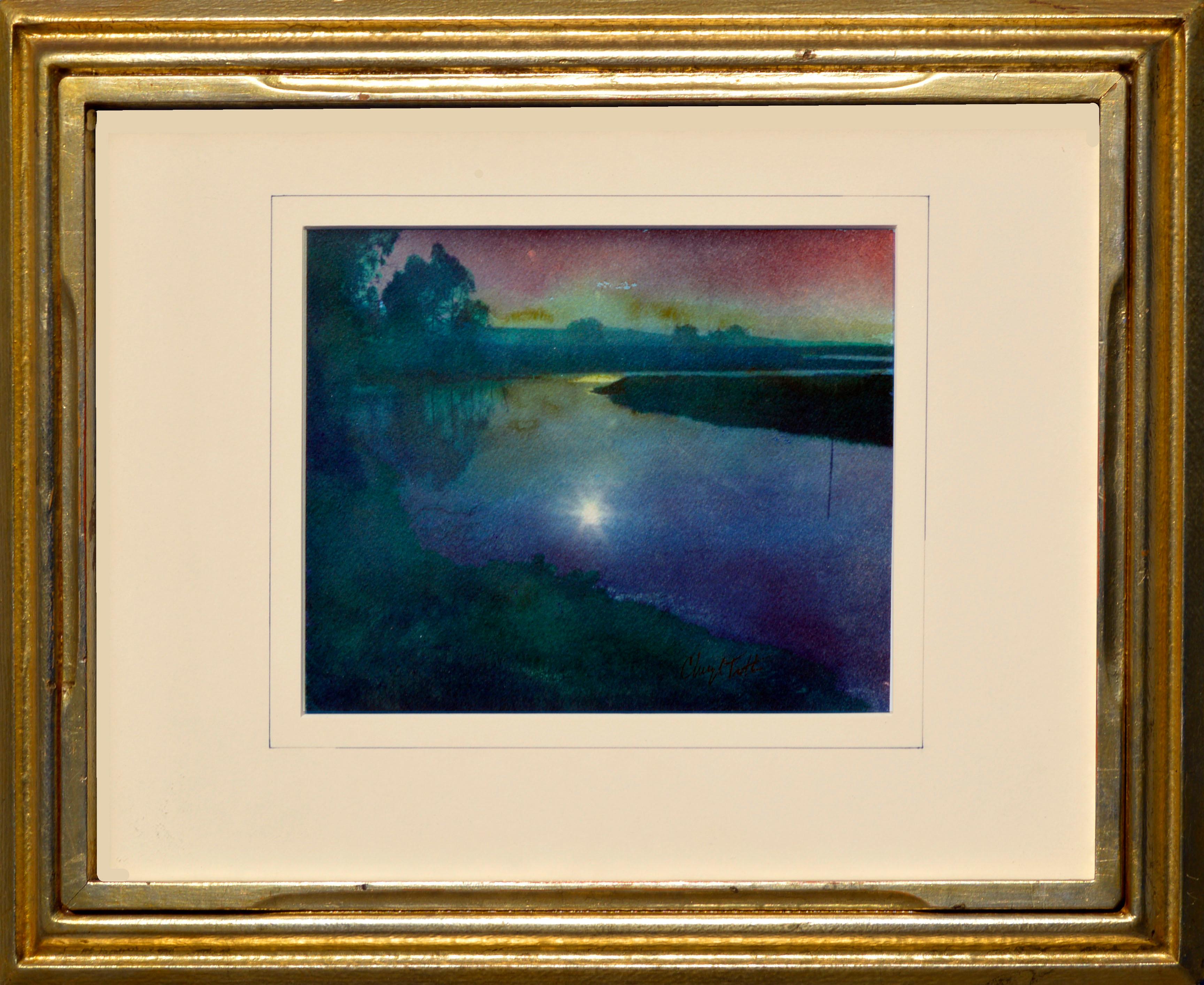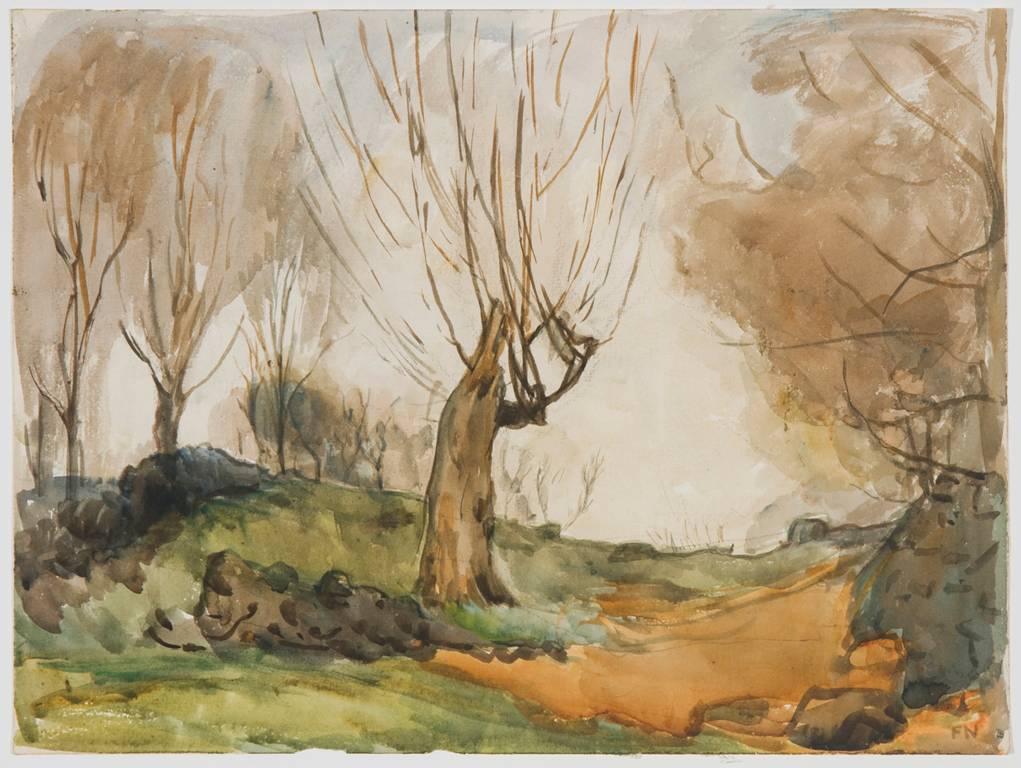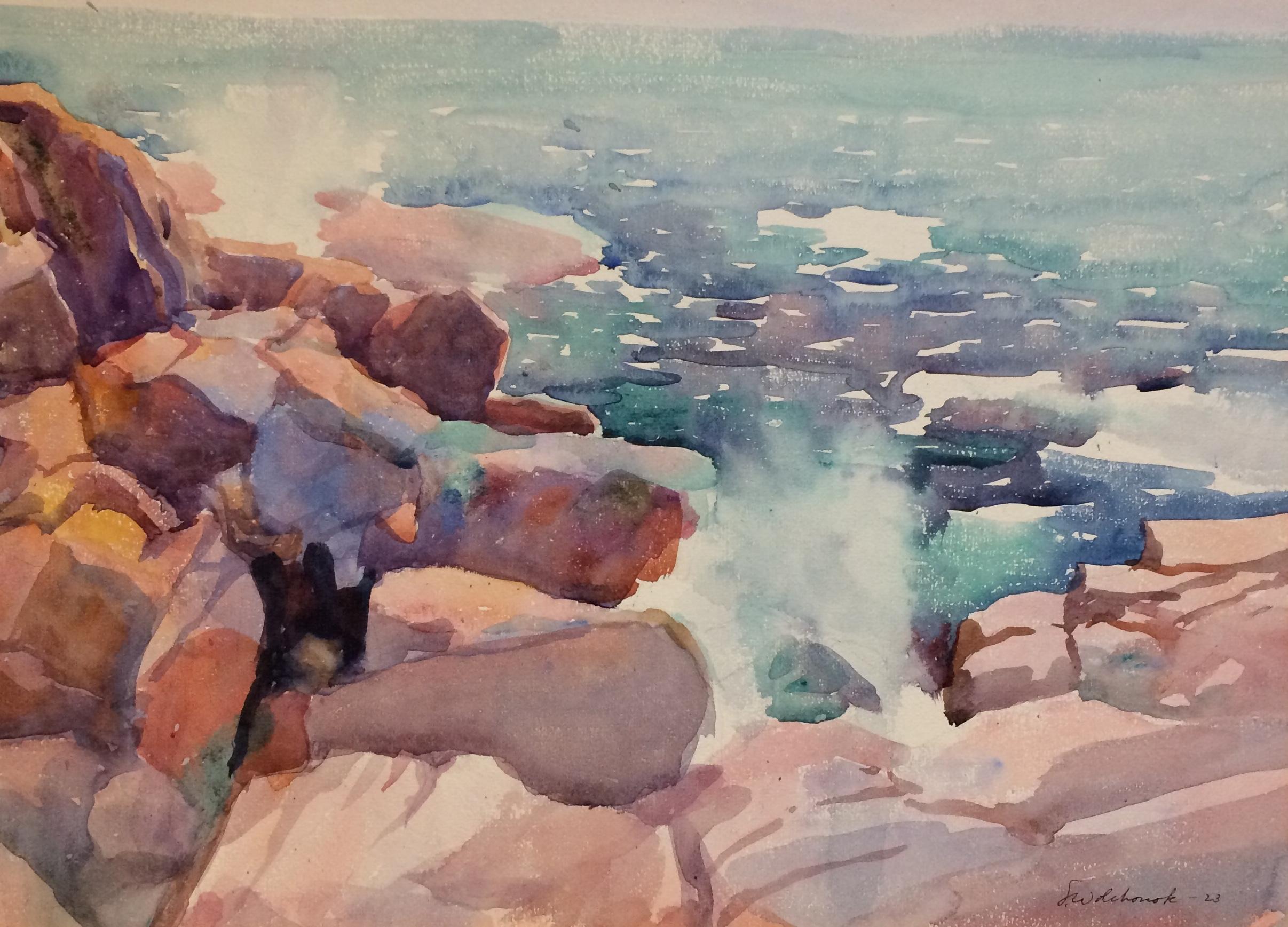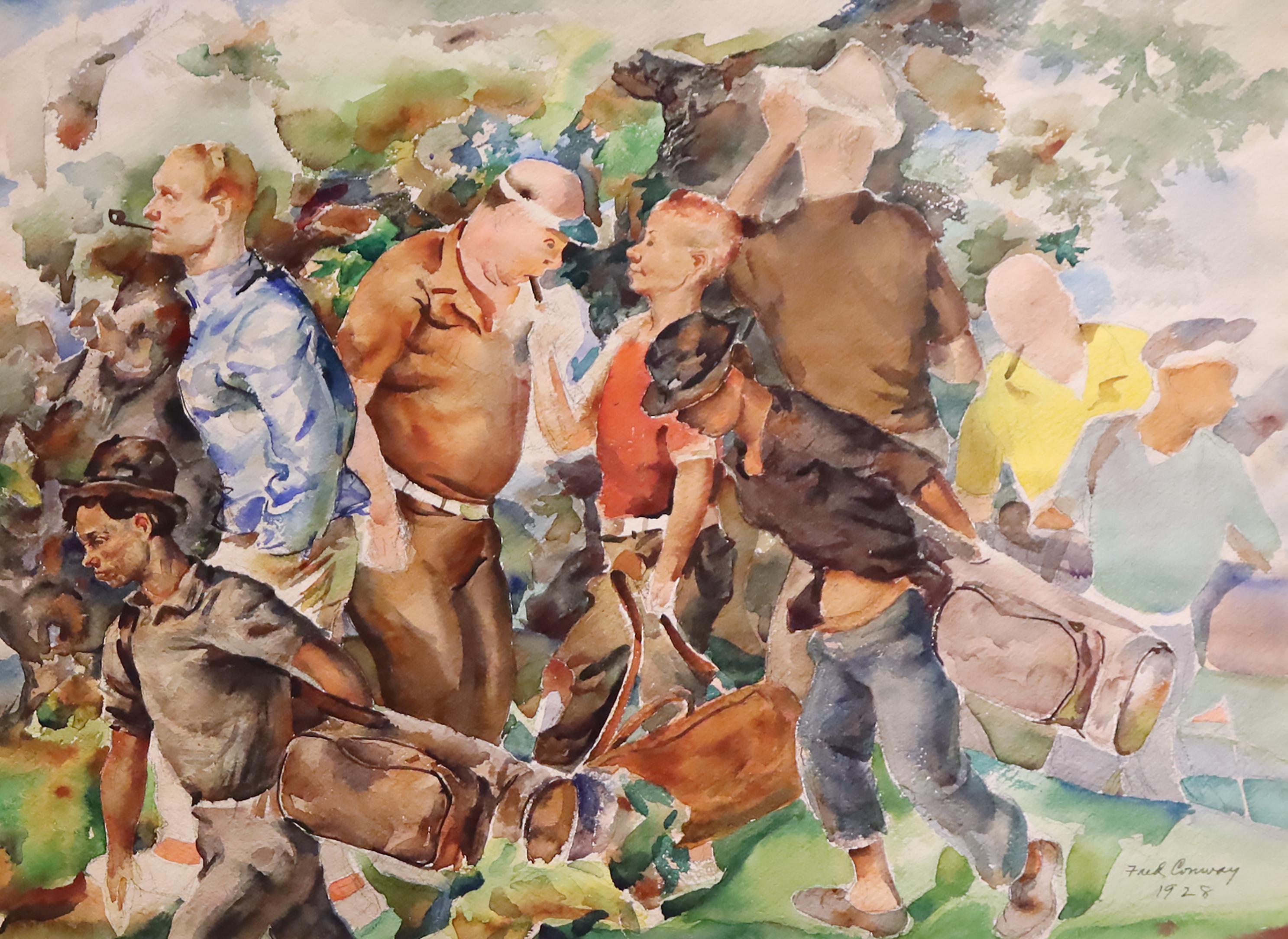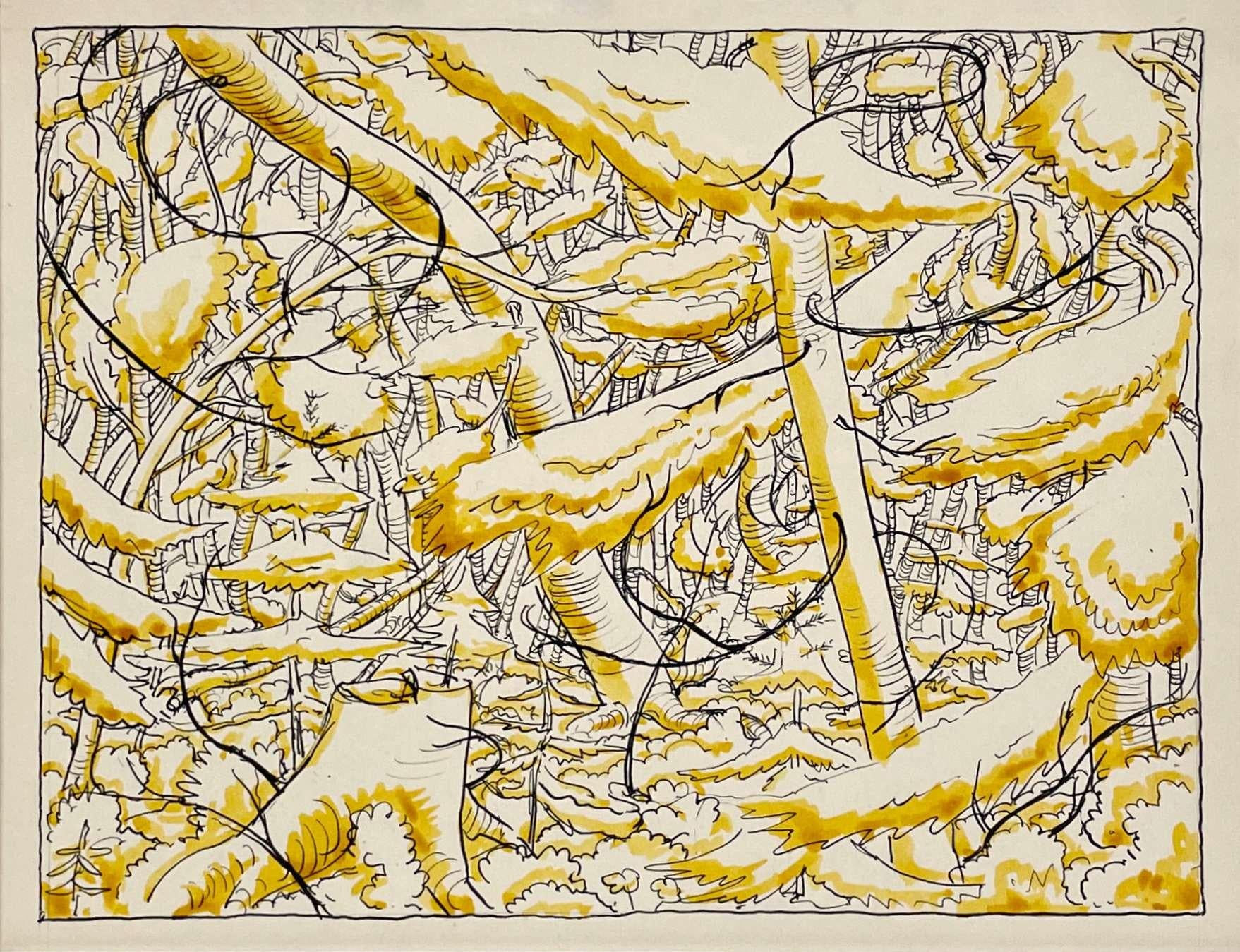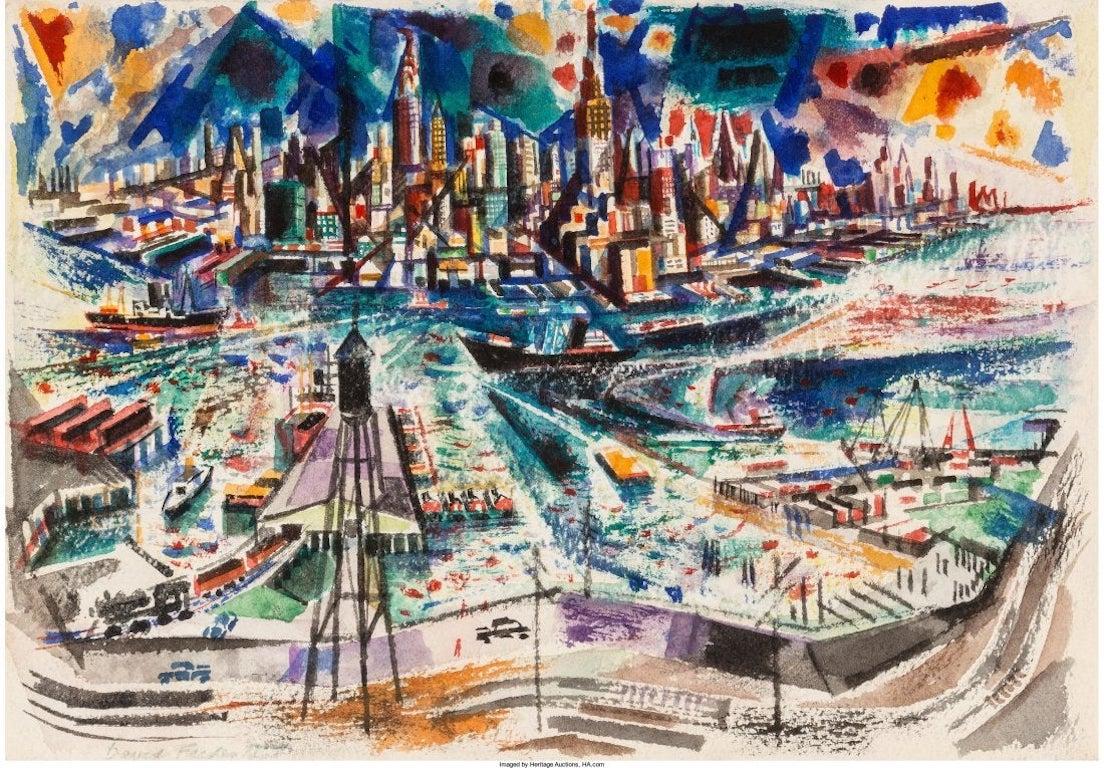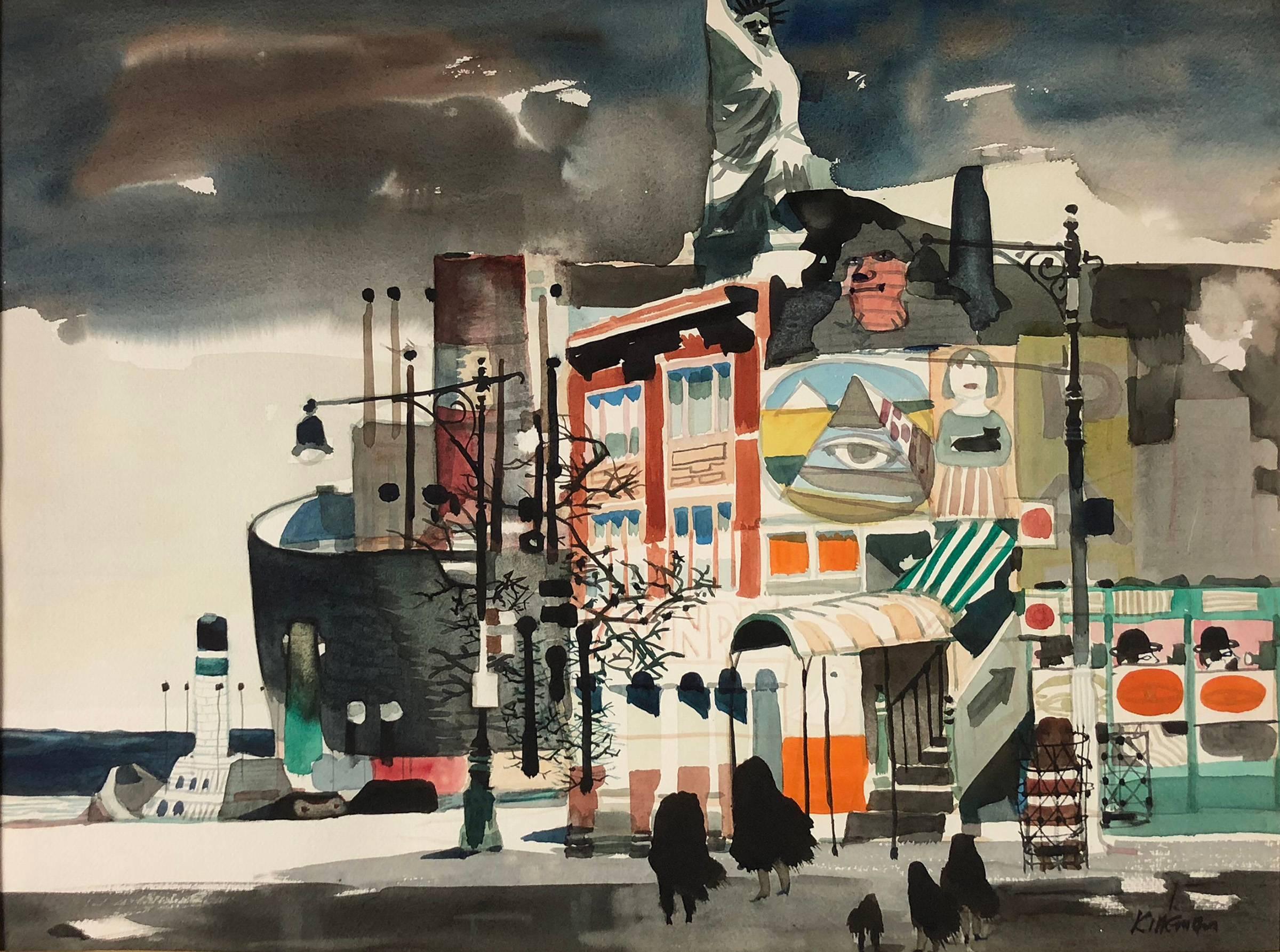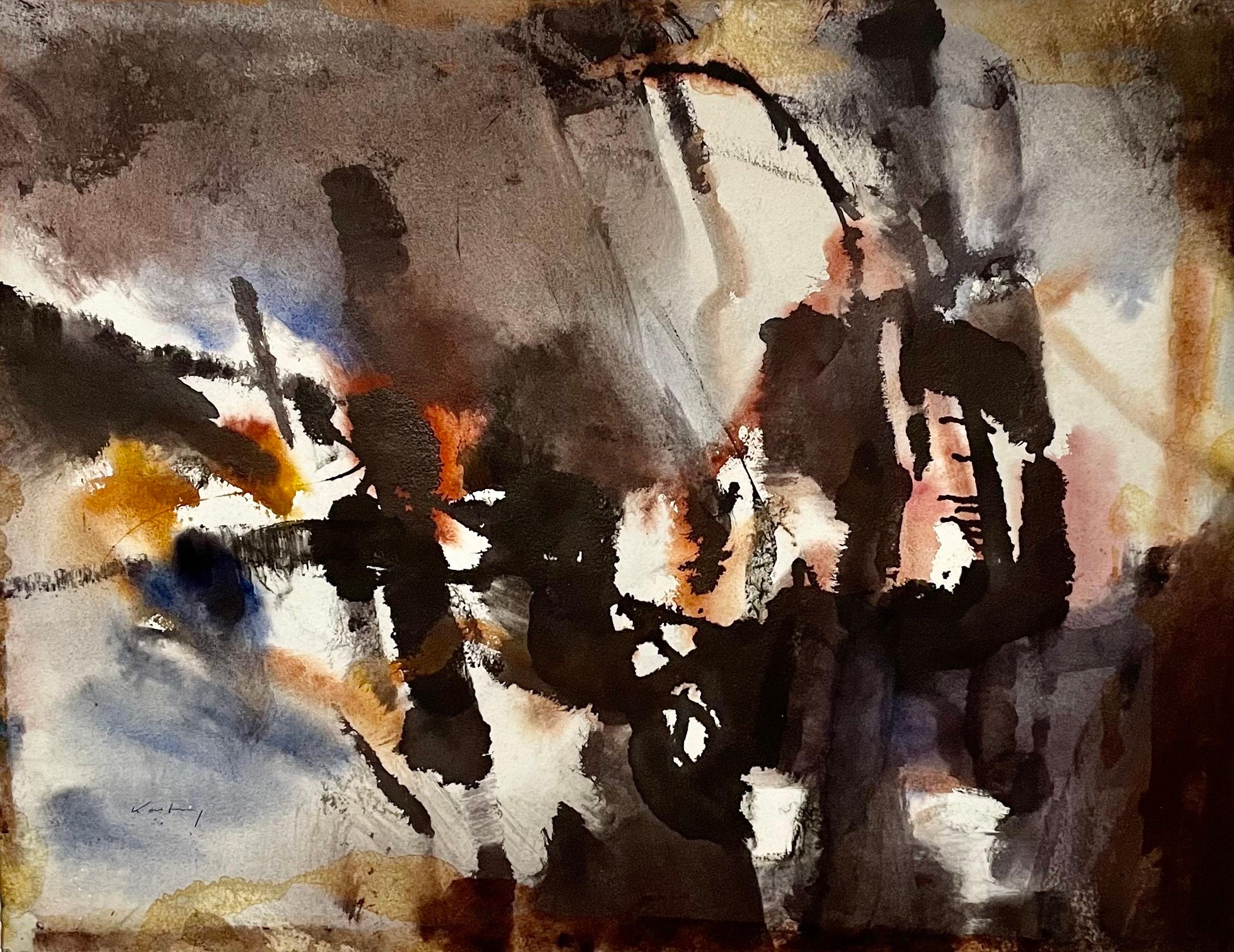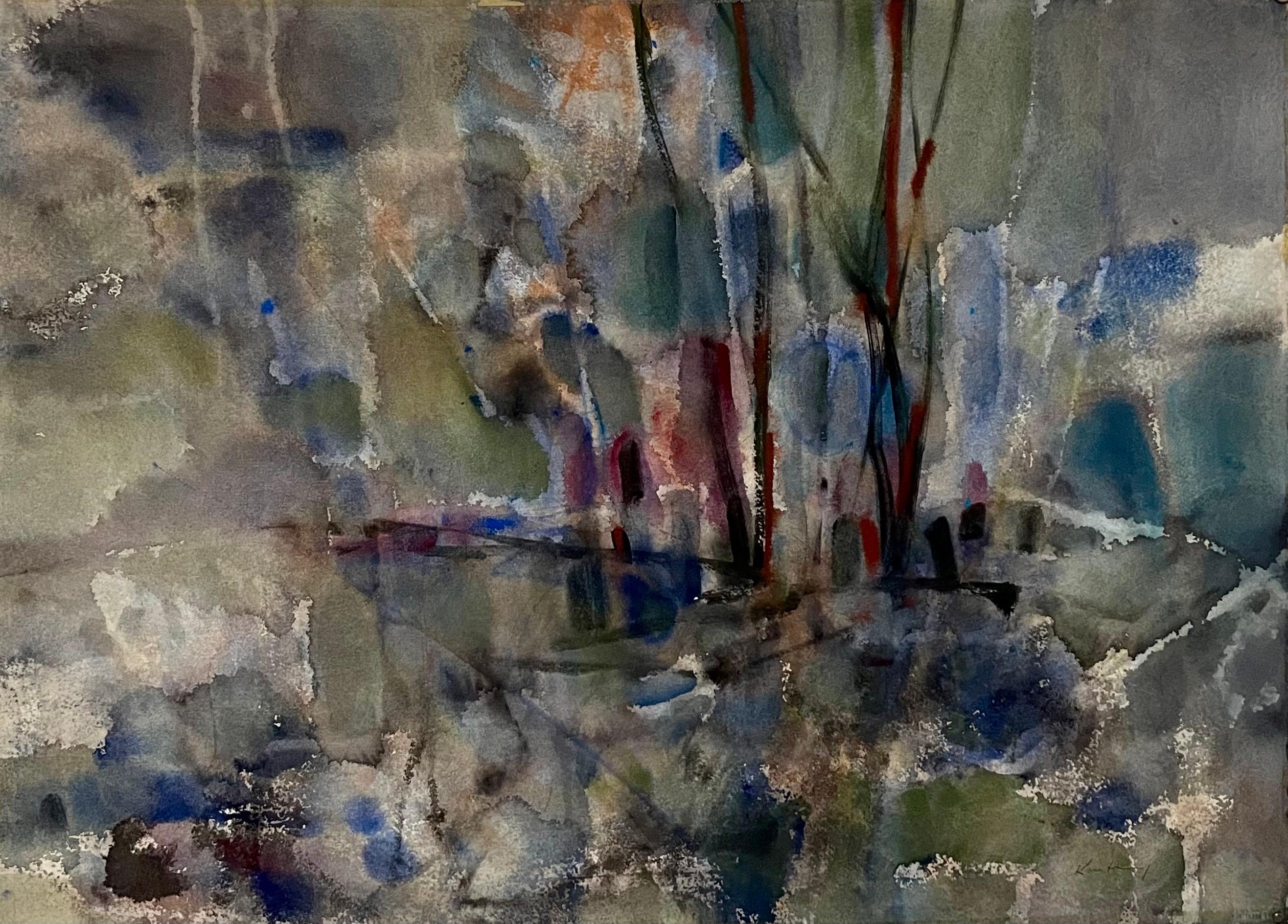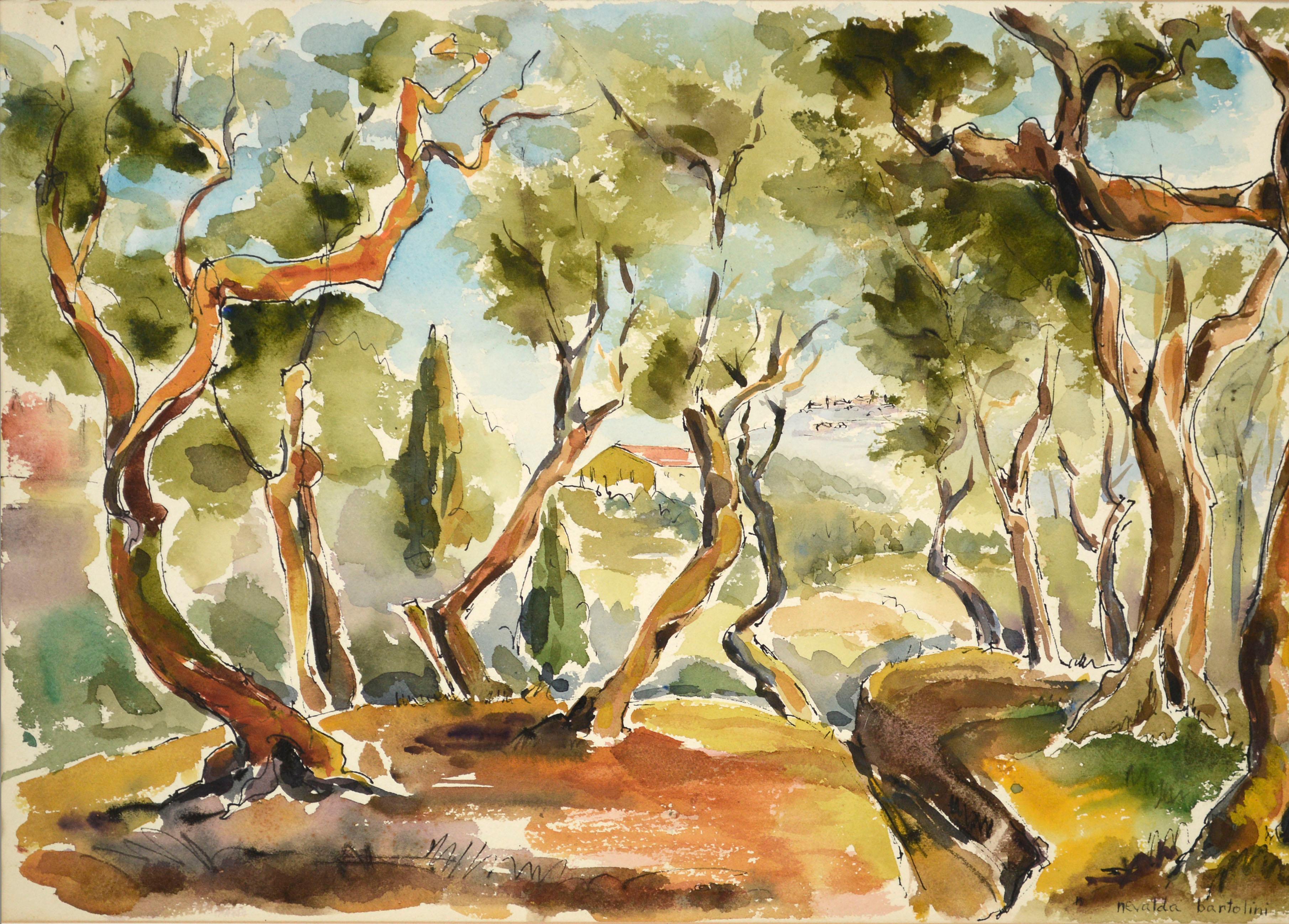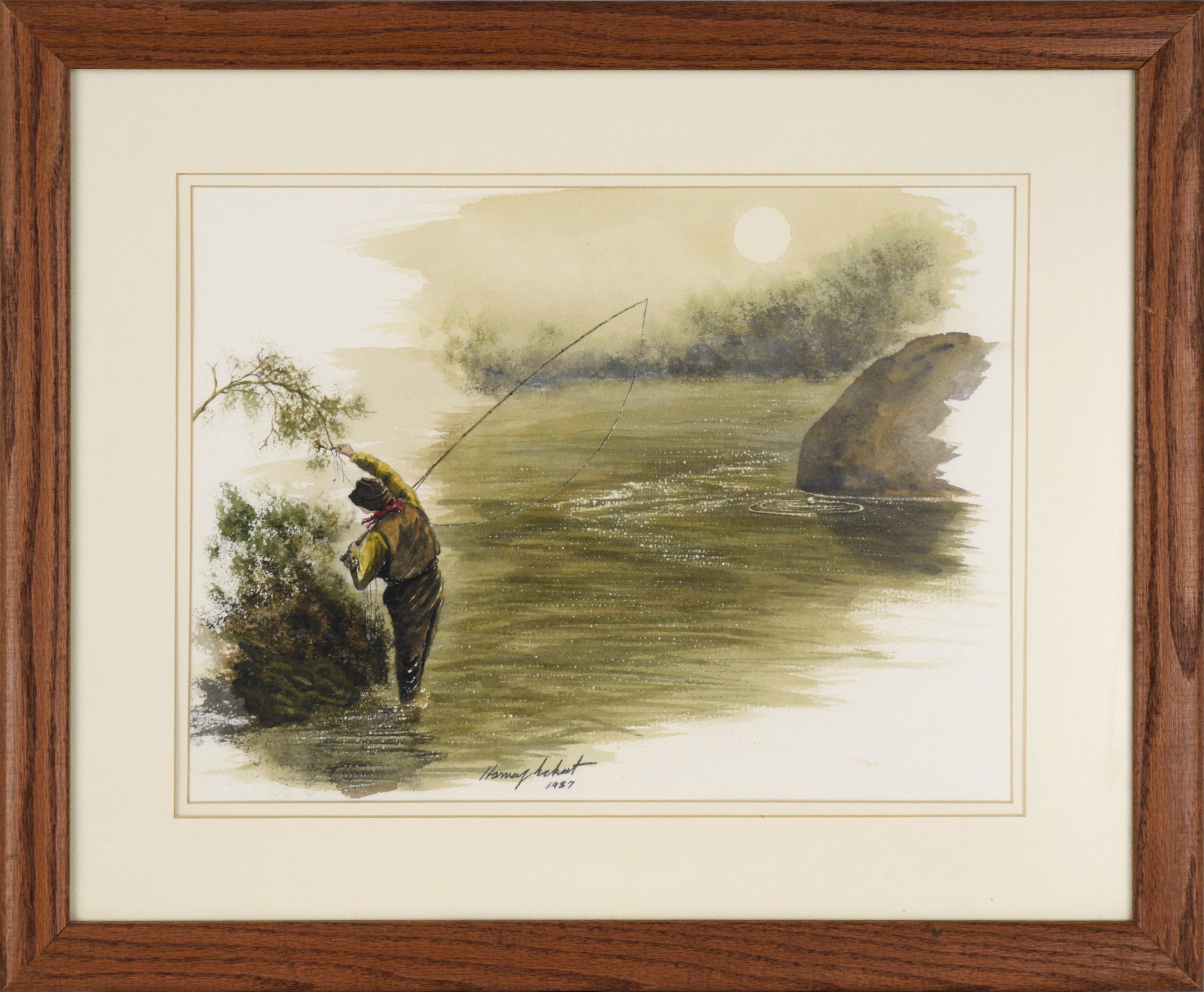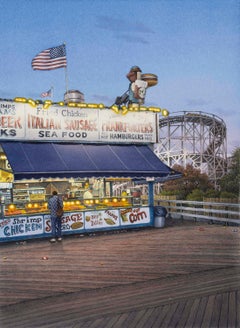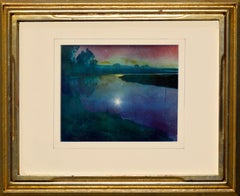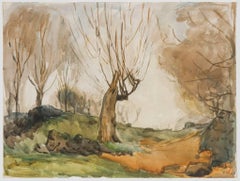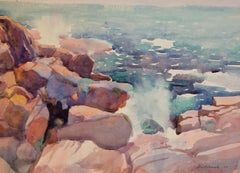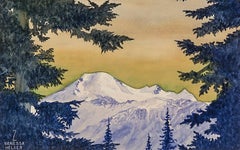
Mount Baker, Washington
View Similar Items
Zama Vanessa HelderMount Baker, Washington
About the Item
- Creator:Zama Vanessa Helder (1903 - 1968, American)
- Dimensions:Height: 5.75 in (14.61 cm)Width: 9 in (22.86 cm)
- Medium:
- Movement & Style:
- Period:
- Condition:
- Gallery Location:New York, NY
- Reference Number:Seller: APG 83481stDibs: LU234875151
Zama Vanessa Helder
West Coast artist Z. Vanessa Helder seems to have been prepared from the start to pursue an independent course in art. Her full name, Zama Vanessa Helder, curiously was chosen by her parents to represent a town in North Africa and the name of a former music teacher, respectively, but she preferred the more mysterious Z. Vanessa Helder, or more simply “Zelma.” She was born in Lynden, Washington, a small town near Spokane. Her mother, Anna Wright Helder, was an artist, so it is not surprising that she started painting at a young age, and that she decided early on to pursue a career as a professional artist.
Helder enrolled at the University of Washington, Seattle, where she received her first formal studies. Following her graduation, Helder began her professional career in Seattle, where she established herself as a specialist in watercolor. She was recognized for her artistic talents in 1934, when she was awarded a two-year scholarship by the Art Students League, New York. She was one of only ten outstanding artists from the United States so awarded. At the League, she studied with Frank Vincent DuMond, George Picken, and Robert Brackman. Helder’s course of study at the Art Students League proved to be enormously influential. She not only refined her watercolor technique, but also added oil painting and lithography to her repertoire. Furthermore, her exposure to contemporary American modernism, which was then the dominant mode in the New York art world, had a decided impact on the development of her own work.
Soon after her arrival in New York City and subsequent matriculation at the Art Students League, Helder’s career accelerated rapidly, in a way only possible in the New York art world. In 1935, she began to participate in a number of group shows in New York galleries and clubs, including the New York Watercolor Club, and she was elected that year to the National Association of Women Painters and Sculptors. In 1937, she was given her first “one-man” show at the Grant Studios, New York, an institution with which she maintained a relationship for several years.
During this period in New York, Helder frequently sent works to Seattle for exhibition. She remained the darling of Seattle’s art society, with frequent reports of her activities in New York appearing in the local newspapers. After she completed her studies at the Art Students League, Helder returned to Seattle, where for many years she was a popular local figure, noted as much for her art as for her idiosyncratic behavior, which included walking “Sniffy,” her pet skunk, prominently throughout the streets of Seattle. She also worked locally as a WPA artist, painting murals in various civic buildings. She exhibited annually at the Seattle Art Museum from 1936 to 1941, capped by winning a prize in 1936, and holding a solo exhibition there in 1939. Helder also participated in exhibitions throughout the West, including at the San Francisco Museum of Art, California, in 1936-37; the Portland Art Museum, Oregon, in 1936; and the Denver Art Museum, Colorado, in 1938 and 1940.
About 1939, Helder moved to Spokane, where she helped found the Spokane Art Center, an art school at which she was an instructor in both watercolor and lithography. She spent three productive years there until 1941, when the federal government, which had funded the center from its inception, canceled its financial support. Later that year, Helder returned to New York, and soon after married Robert S. J. Paterson, an industrial architect. Helder, ever the individualist, retained her distinctive maiden name. In 1943, the couple moved to Los Angeles, California, where she remained until her death in 1968. She was as active as ever, exhibiting annually at the Los Angeles County Museum of Art, from 1945 to 1948, as well as at a number of Southern California institutions until the late 1950s. Throughout her career, she remained a committed watercolorist, exhibiting regularly at the American Water Color Society, from 1936 to 1958, and the California Water Color Society, from 1939 to 1958. Today her work is held in a number of museum collections, including the Newark Museum, New Jersey; the High Museum of Art, Atlanta, Georgia; the American Academy of Arts and Letters, New York; and the Cheney Cowles Museum, Spokane.
Helder’s style is notable for the sharp, almost austere precision of her drawing and her coolly modulated palette. Her work certainly suggests a Precisionist linearity and objectivity that one normally associates with artists such as Charles Sheeler and Ralston Crawford. However, unlike these artists, who typically isolate elements of machinery and architecture from nature, Helder usually juxtaposes man-made objects with natural ones, treating all elements with the same cold, objective treatment. Her best works are winter scenes, which, because of the naturally stark character of the season, are complemented by her uncompromising eye.
The high point of Helder’s career came in 1943, when she was represented by 12 watercolors in “American Realists and Magic Realists,” a huge exhibition at the Museum of Modern Art, New York. The exhibition included work from past American masters, such as Rembrandt Peale, Thomas Cole, Thomas Eakins, and Winslow Homer, and contemporary artists, including Edward Hopper, Charles Sheeler, Louis Lozowick, Ben Shahn, and Andrew Wyeth. The fact that Helder was represented alongside these artists is a testament to the popularity of her art and the singularity of her vision.
(Biography provided by Hirschl & Adler)
- Study for Old Canal, Red and Blue (Rockaway, Morris Canal)By Oscar Florianus BluemnerLocated in New York, NYOscar Bluemner was a German and an American, a trained architect who read voraciously in art theory, color theory, and philosophy, a writer of art criticism both in German and English, and, above all, a practicing artist. Bluemner was an intense man, who sought to express and share, through drawing and painting, universal emotional experience. Undergirded by theory, Bluemner chose color and line for his vehicles; but color especially became the focus of his passion. He was neither abstract artist nor realist, but employed the “expressional use of real phenomena” to pursue his ends. (Oscar Bluemner, from unpublished typescript on “Modern Art” for Camera Work, in Bluemner papers, Archives of American Art, Smithsonian Institution, as cited and quoted in Jeffrey R. Hayes, Oscar Bluemner [1991], p. 60. The Bluemner papers in the Archives [hereafter abbreviated as AAA] are the primary source for Bluemner scholars. Jeffrey Hayes read them thoroughly and translated key passages for his doctoral dissertation, Oscar Bluemner: Life, Art, and Theory [University of Maryland, 1982; UMI reprint, 1982], which remains the most comprehensive source on Bluemner. In 1991, Hayes published a monographic study of Bluemner digested from his dissertation and, in 2005, contributed a brief essay to the gallery show at Barbara Mathes, op. cit.. The most recent, accessible, and comprehensive view of Bluemner is the richly illustrated, Barbara Haskell, Oscar Bluemner: A Passion for Color, exhib. cat. [New York: Whitney Museum of American Art, 2005.]) Bluemner was born in the industrial city of Prenzlau, Prussia, the son and grandson of builders and artisans. He followed the family predilection and studied architecture, receiving a traditional and thorough German training. He was a prize-winning student and appeared to be on his way to a successful career when he decided, in 1892, to emigrate to America, drawn perhaps by the prospect of immediate architectural opportunities at the Chicago World’s Fair, but, more importantly, seeking a freedom of expression and an expansiveness that he believed he would find in the New World. The course of Bluemner’s American career proved uneven. He did indeed work as an architect in Chicago, but left there distressed at the formulaic quality of what he was paid to do. Plagued by periods of unemployment, he lived variously in Chicago, New York, and Boston. At one especially low point, he pawned his coat and drafting tools and lived in a Bowery flophouse, selling calendars on the streets of New York and begging for stale bread. In Boston, he almost decided to return home to Germany, but was deterred partly because he could not afford the fare for passage. He changed plans and direction again, heading for Chicago, where he married Lina Schumm, a second-generation German-American from Wisconsin. Their first child, Paul Robert, was born in 1897. In 1899, Bluemner became an American citizen. They moved to New York City where, until 1912, Bluemner worked as an architect and draftsman to support his family, which also included a daughter, Ella Vera, born in 1903. All the while, Oscar Bluemner was attracted to the freer possibilities of art. He spent weekends roaming Manhattan’s rural margins, visiting the Bronx, Brooklyn, Queens, and New Jersey, sketching landscapes in hundreds of small conté crayon drawings. Unlike so many city-based artists, Bluemner did not venture out in search of pristine countryside or unspoiled nature. As he wrote in 1932, in an unsuccessful application for a Guggenheim Fellowship, “I prefer the intimate landscape of our common surroundings, where town and country mingle. For we are in the habit to carry into them our feelings of pain and pleasure, our moods” (as quoted by Joyce E. Brodsky in “Oscar Bluemner in Black and White,” p. 4, in Bulletin 1977, I, no. 5, The William Benton Museum of Art, Storrs, Connecticut). By 1911, Bluemner had found a powerful muse in a series of old industrial towns, mostly in New Jersey, strung along the route of the Morris Canal. While he educated himself at museums and art galleries, Bluemner entered numerous architectural competitions. In 1903, in partnership with Michael Garven, he designed a new courthouse for Bronx County. Garven, who had ties to Tammany Hall, attempted to exclude Bluemner from financial or artistic credit, but Bluemner promptly sued, and, finally, in 1911, after numerous appeals, won a $7,000 judgment. Barbara Haskell’s recent catalogue reveals more details of Bluemner’s architectural career than have previously been known. Bluemner the architect was also married with a wife and two children. He took what work he could get and had little pride in what he produced, a galling situation for a passionate idealist, and the undoubted explanation for why he later destroyed the bulk of his records for these years. Beginning in 1907, Bluemner maintained a diary, his “Own Principles of Painting,” where he refined his ideas and incorporated insights from his extensive reading in philosophy and criticism both in English and German to create a theoretical basis for his art. Sometime between 1908 and 1910, Bluemner’s life as an artist was transformed by his encounter with the German-educated Alfred Stieglitz, proprietor of the Little Galleries of the Photo-Secession at 291 Fifth Avenue. The two men were kindred Teutonic souls. Bluemner met Stieglitz at about the time that Stieglitz was shifting his serious attention away from photography and toward contemporary art in a modernist idiom. Stieglitz encouraged and presided over Bluemner’s transition from architect to painter. During the same period elements of Bluemner’s study of art began to coalesce into a personal vision. A Van Gogh show in 1908 convinced Bluemner that color could be liberated from the constraints of naturalism. In 1911, Bluemner visited a Cézanne watercolor show at Stieglitz’s gallery and saw, in Cézanne’s formal experiments, a path for uniting Van Gogh’s expressionist use of color with a reality-based but non-objective language of form. A definitive change of course in Bluemner’s professional life came in 1912. Ironically, it was the proceeds from his successful suit to gain credit for his architectural work that enabled Bluemner to commit to painting as a profession. Dividing the judgment money to provide for the adequate support of his wife and two children, he took what remained and financed a trip to Europe. Bluemner traveled across the Continent and England, seeing as much art as possible along the way, and always working at a feverish pace. He took some of his already-completed work with him on his European trip, and arranged his first-ever solo exhibitions in Berlin, Leipzig, and Elberfeld, Germany. After Bluemner returned from his study trip, he was a painter, and would henceforth return to drafting only as a last-ditch expedient to support his family when his art failed to generate sufficient income. Bluemner became part of the circle of Stieglitz artists at “291,” a group which included Marsden Hartley, John Marin, and Arthur Dove. He returned to New York in time to show five paintings at the 1913 Armory Show and began, as well, to publish critical and theoretical essays in Stieglitz’s journal, Camera Work. In its pages he cogently defended the Armory Show against the onslaught of conservative attacks. In 1915, under Stieglitz’s auspices, Bluemner had his first American one-man show at “291.” Bluemner’s work offers an interesting contrast with that of another Stieglitz architect-turned-artist, John Marin, who also had New Jersey connections. The years after 1914 were increasingly uncomfortable. Bluemner remained, all of his life, proud of his German cultural legacy, contributing regularly to German language journals and newspapers in this country. The anti-German sentiment, indeed mania, before and during World War I, made life difficult for the artist and his family. It is impossible to escape the political agenda in Charles Caffin’s critique of Bluemner’s 1915 show. Caffin found in Bluemner’s precise and earnest explorations of form, “drilled, regimented, coerced . . . formations . . . utterly alien to the American idea of democracy” (New York American, reprinted in Camera Work, no. 48 [Oct. 1916], as quoted in Hayes, 1991, p. 71). In 1916, seeking a change of scene, more freedom to paint, and lower expenses, Bluemner moved his family to New Jersey, familiar terrain from his earlier sketching and painting. During the ten years they lived in New Jersey, the Bluemner family moved around the state, usually, but not always, one step ahead of the rent collector. In 1917, Stieglitz closed “291” and did not reestablish a Manhattan gallery until 1925. In the interim, Bluemner developed relationships with other dealers and with patrons. Throughout his career he drew support and encouragement from art cognoscenti who recognized his talent and the high quality of his work. Unfortunately, that did not pay the bills. Chronic shortfalls were aggravated by Bluemner’s inability to sustain supportive relationships. He was a difficult man, eternally bitter at the gap between the ideal and the real. Hard on himself and hard on those around him, he ultimately always found a reason to bite the hand that fed him. Bluemner never achieved financial stability. He left New Jersey in 1926, after the death of his beloved wife, and settled in South Braintree, Massachusetts, outside of Boston, where he continued to paint until his own death in 1938. As late as 1934 and again in 1936, he worked for New Deal art programs designed to support struggling artists. Bluemner held popular taste and mass culture in contempt, and there was certainly no room in his quasi-religious approach to art for accommodation to any perceived commercial advantage. His German background was also problematic, not only for its political disadvantages, but because, in a world where art is understood in terms of national styles, Bluemner was sui generis, and, to this day, lacks a comfortable context. In 1933, Bluemner adopted Florianus (definitively revising his birth names, Friedrich Julius Oskar) as his middle name and incorporated it into his signature, to present “a Latin version of his own surname that he believed reinforced his career-long effort to translate ordinary perceptions into the more timeless and universal languages of art” (Hayes 1982, p. 189 n. 1). In 1939, critic Paul Rosenfeld, a friend and member of the Stieglitz circle, responding to the difficulty in categorizing Bluemner, perceptively located him among “the ranks of the pre-Nazi German moderns” (Hayes 1991, p. 41). Bluemner was powerfully influenced in his career by the intellectual heritage of two towering figures of nineteenth-century German culture, Johann Wolfgang von Goethe and Georg Wilhelm Friedrich Hegel. A keen student of color theory, Bluemner gave pride of place to the formulations of Goethe, who equated specific colors with emotional properties. In a November 19, 1915, interview in the German-language newspaper, New Yorker Staats-Zeitung (Abendblatt), he stated: I comprehend the visible world . . . abstract the primary-artistic . . . and after these elements of realty are extracted and analyzed, I reconstruct a new free creation that still resembles the original, but also . . . becomes an objectification of the abstract idea of beauty. The first—and most conspicuous mark of this creation is . . . colors which accord with the character of things, the locality . . . [and which] like the colors of Cranach, van der Weyden, or Durer, are of absolute purity, breadth, and luminosity. . . . I proceed from the psychological use of color by the Old Masters . . . [in which] we immediately recognize colors as carriers of “sorrow and joy” in Goethe’s sense, or as signs of human relationship. . . . Upon this color symbolism rests the beauty as well as the expressiveness, of earlier sacred paintings. Above all, I recognize myself as a contributor to the new German theory of light and color, which expands Goethe’s law of color through modern scientific means (as quoted in Hayes 1991, p. 71). Hayes has traced the global extent of Bluemner’s intellectual indebtedness to Hegel (1991, pp. 36–37). More specifically, Bluemner made visual, in his art, the Hegelian world view, in the thesis and antithesis of the straight line and the curve, the red and the green, the vertical and the horizontal, the agitation and the calm. Bluemner respected all of these elements equally, painting and drawing the tension and dynamic of the dialectic and seeking ultimate reconciliation in a final visual synthesis. Bluemner was a keen student of art, past and present, looking, dissecting, and digesting all that he saw. He found precedents for his non-naturalist use of brilliant-hued color not only in the work Van Gogh and Cezanne, but also in Gauguin, the Nabis, and the Symbolists, as well as among his contemporaries, the young Germans of Der Blaue Reiter. Bluemner was accustomed to working to the absolute standard of precision required of the architectural draftsman, who adjusts a design many times until its reality incorporates both practical imperatives and aesthetic intentions. Hayes describes Bluemner’s working method, explaining how the artist produced multiple images playing on the same theme—in sketch form, in charcoal, and in watercolor, leading to the oil works that express the ultimate completion of his process (Hayes, 1982, pp. 156–61, including relevant footnotes). Because of Bluemner’s working method, driven not only by visual considerations but also by theoretical constructs, his watercolor and charcoal studies have a unique integrity. They are not, as is sometimes the case with other artists, rough preparatory sketches. They stand on their own, unfinished only in the sense of not finally achieving Bluemner’s carefully considered purpose. The present charcoal drawing is one of a series of images that take as their starting point the Morris Canal as it passed through Rockaway, New Jersey. The Morris Canal industrial towns that Bluemner chose as the points of departure for his early artistic explorations in oil included Paterson with its silk mills (which recalled the mills in the artist’s childhood home in Elberfeld), the port city of Hoboken, Newark, and, more curiously, a series of iron ore mining and refining towns, in the north central part of the state that pre-dated the Canal, harkening back to the era of the Revolutionary War. The Rockaway theme was among the original group of oil paintings that Bluemner painted in six productive months from July through December 1911 and took with him to Europe in 1912. In his painting journal, Bluemner called this work Morris Canal at Rockaway N.J. (AAA, reel 339, frames 150 and 667, Hayes, 1982, pp. 116–17), and exhibited it at the Galerie Fritz Gurlitt in Berlin in 1912 as Rockaway N. J. Alter Kanal. After his return, Bluemner scraped down and reworked these canvases. The Rockaway picture survives today, revised between 1914 and 1922, as Old Canal, Red and Blue (Rockaway River) in the collection of the Hirshhorn Museum and Sculpture Garden, Smithsonian Institution, Washington D. C. (color illus. in Haskell, fig. 48, p. 65). For Bluemner, the charcoal expression of his artistic vision was a critical step in composition. It represented his own adaptation of Arthur Wesley’s Dow’s (1857–1922) description of a Japanese...Category
20th Century American Modern Abstract Drawings and Watercolors
MaterialsPaper, Charcoal
- Flyer's Boat Rental, ProvincetownBy Frederick BrosenLocated in New York, NYSigned and dated (at lower right): BROSEN ’23, titled (at lower left): FLYER’S BOAT RENTAL, PROVINCETOWN A native New Yorker, Brosen has spent a lifetime wandering its streets, disco...Category
2010s Contemporary Landscape Drawings and Watercolors
MaterialsGraphite, Watercolor, Paper
- Along the BoardwalkBy Frederick BrosenLocated in New York, NYSigned and dated (at lower right): BROSEN; titled (at lower left): Boardwalk, Coney Island A native New Yorker, Brosen has spent a lifetime wandering its streets, discovering its l...Category
2010s Contemporary Drawings and Watercolor Paintings
MaterialsGraphite, Watercolor, Paper
- Bethesda Fountain TerraceBy Frederick BrosenLocated in New York, NYSigned and dated (at lower right): BROSEN 22 A native New Yorker, Brosen has spent a lifetime wandering its streets, discovering its long history and witnessing its constant metamor...Category
2010s Landscape Drawings and Watercolors
MaterialsPaper, Watercolor, Graphite
- WonderBy Frederick BrosenLocated in New York, NYSigned and dated (at lower right): BROSEN•20 A native New Yorker, Brosen has spent a lifetime wandering its streets, discovering its long history and witnessing its constant metamor...Category
2010s Landscape Drawings and Watercolors
MaterialsPaper, Watercolor, Graphite
$44,000 - San Gio, ComoBy Eleanor Parke CustisLocated in New York, NYEleanor Park Custis painted scenes as varied as the artist's travels: from her hometown of Washington, D.C., to the coastal towns of New England; from the prosperous fishing villages of Brittany, to Venice and the mountain villages and lakes of northern Italy. While Custis's subjects are diverse, her style is consistent and distinctive throughout this body of work. Her use of flat areas of color delineated by dark contours is reminiscent of the aesthetics of woodblock printing. Like many artists of the day, she was profoundly influenced by Japanese woodblock prints, and her adaptation of the aesthetic by 1924 led to her most productive artistic period. Eleanor Custis hailed from a socially prominent Washington, D.C., family. She was distantly related to Martha Custis Washington, America's first First Lady. Custis began three years of formal art training in the autumn of 1915 at the Corcoran School of Art in Washington, and was guided and inspired by Impressionist artist Edmund C. Tarbell, one of the Ten American Painters, who became the Corcoran School's principal in 1918. Custis exhibited widely in many of the Washington art societies and clubs for much of her career. She was also a frequent exhibitor at the Grand Central Art Galleries in New York City; her last one-woman show there was in April 1945. Custis's mature style emerged in scenes of the streets, wharves, and drydocks of seacoast villages from Maine to Massachusetts, which she visited during the summers of 1924 and 1925. She was working in Gloucester, Massachusetts in August 1924, and painted several gouaches of the town's wharves and winding streets, including In Gloucester Harbor and At the Drydock, Gloucester. During her stay, Custis may have met Jane Peterson or at least must have seen her work, the best of which was executed in Gloucester during the preceding ten years. The similarity between their styles is unmistakable, but, while it may be tempting to suggest that Custis was influenced by Peterson during her summer in Gloucester, the connection between their work is probably more a case of shared aesthetics and common European influences. Custis expanded her subject repertoire with three trips to Europe between 1926 and 1929, and was inspired by the Old World charm of Holland, northern France, Switzerland, and Italy, leading to such works as New Kirk, Delft, Holland, Market Day in Quimper, At the Foot of the Matterhorn, and The Town Square, Varenna. A Mediterranean cruise in 1934 introduced her to the Near East, and the bustling, colorful streets and bazaars of Cairo, captured in works like A Street in Cairo, Egypt and A Moroccan Jug...Category
20th Century American Realist Landscape Drawings and Watercolors
MaterialsPaper, Gouache
- "Elkhorn Slough" - Cyanotype / Watercolor LandscapeBy Cheryl TrotterLocated in Soquel, CASoft watercolor accents add to the beauty of this cyanotype and watercolor titled "Elkhorn Slough" by Cheryl Trotter (American, 20th century), c.1980's....Category
1980s American Modern Mixed Media
MaterialsWatercolor, Laid Paper, Photographic Paper
- Untitled (Tree)By Fred NaglerLocated in Dallas, TXFred Nagler was born in 1891 in Springfield, Massachusetts, where he first studied wood carving. From 1914 to 1917, he studied at The Art Students League of New York, where his prof...Category
20th Century American Modern Landscape Drawings and Watercolors
MaterialsGraphite, Paper, Watercolor
- "Bass Rocks, Gloucester, Massachusetts" Watercolor Bright SeascapeBy Louis WolchonokLocated in New York, NYLouis Wolchonok (1898 - 1973) Bass Rocks, Gloucester, Massachusetts, 1923 Watercolor on wove watercolor stock paper 13 x 17 3/4 inches Signed and dated lower right corner: LWolchonok...Category
1920s American Modern Landscape Drawings and Watercolors
MaterialsPaper, Watercolor
- GolfersBy Frederick ConwayLocated in Missouri, MOGolfers, 1928 Fred Conway (American, 1900-1973) Signed and Dated Lower Right 18.5 x 24.5 inches 30.5 x 37 inches with frame A member of the faculty of the Washington University Art ...Category
1920s American Modern Figurative Drawings and Watercolors
MaterialsPaper, Watercolor
Price Upon Request - Forest Scene, Study in Yellow by artist Harold HaydonBy Harold HaydonLocated in Chicago, ILA ca. 1931 charming watercolor forest scene; a study in yellow by artist Harold Haydon. Harold Emerson Haydon was born in Fort William, Ontario, Canad...Category
1930s American Modern Landscape Drawings and Watercolors
MaterialsInk, Pen, Watercolor, Paper
- NYC Watercolor Drawing American Modern 20th Century Modernism Mid-Century WPABy David FredenthalLocated in New York, NYNYC Watercolor Drawing American Modern 20th Century Modernism Mid-Century WPA. David Fredenthal (1914-1958) "View of New York from New Jersey,"7 x 10 inches. Watercolor on Paper, c. 1948. Signed lower right. David Fredenthal (1914 - 1958) was one ot America's most respected watercolor artists. He was famous for his bold, intensely vigorous and complex paintings and drawings that expressed his deep feeling for excitement with life and living. He was a draftsman with seemingly a special gift for catching anything, physically and emotionally on the spot, and he never went anywhere without three or four loaded pens and a sketchbook in his pocket. As part of the WPA project he executed a number of murals including the Sports Pavilion on the Heinz Building of the New York World's Fair 1939. Some of his fresco and mural techniques were inspired by his friendship with Diego Rivera who had admired and encouraged him in the early 1930's. After he won a traveling scholarship to Europe from The Museum of Modern Art at age 19, he was the recipient of two Guggenheim grants in Painting. He had his first solo exhibition at the Downtown Gallery in New York in 1937 at age 23, and many others after that including the Whitney Museum of American Art in 1947. Because of Fredenthal's prodigious drawing gifts, he was chosen by Erskine Caldwell to illustrate his novel "Tobacco Road...Category
1940s American Modern Landscape Drawings and Watercolors
MaterialsPaper, Watercolor
Recently Viewed
View AllRead More
With Works Like ‘Yours Truly,’ Arthur Dove Pioneered Abstract Art in America
New York gallery Hirschl & Adler is exhibiting the bold composition by Dove — who’s hailed as the first American abstract painter — at this year’s Winter Show.
Remarkably, Elizabeth Turk’s Sculptures Highlight the Lost Voices of Extinct Birds
In one of the first live and in-person exhibitions at a Manhattan gallery since last spring, the California-based sculptor gives the lost voices of endangered and extinct birds and animals a magnificent embodied form.
